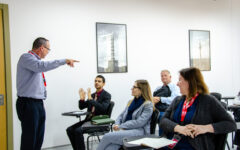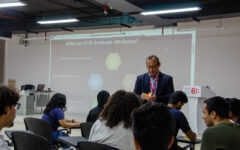Teaching and Learning Bulletin
12/10/2025 2025-10-12 10:51Teaching and Learning Bulletin
Learning Outcomes: Linking Constructive Alignment and Employability Skills
I recently led a Teaching and Learning seminar that focused on how we write, use, and reflect on learning outcomes. The session explored constructive alignment (Biggs and Tang 2011) and how our learning outcomes can do more than list intentions. Learning outcomes should become active tools for designing meaningful learning experiences. In addition to this we looked at ways we can complement good learning outcomes in ways that help our students develop employability skills alongside academic knowledge.
What are learning outcomes?
Learning outcomes articulate what students should be able to do, demonstrate, or understand by the end of a session, module, or programme. Biggs and Tang (2011) describe constructive alignment as the process of ensuring that learning outcomes, learning activities, and assessments work together in an integrated way to support deep, active learning.
In the seminar we focused on the framework, thinking about the following questions:
- What do we want students to learn?
- How will they learn it?
- How will we know they have learned it?
When these three questions align, the outcome verbs (“explain”, “analyse”, “apply”) drive the learning design. Activities should engage the same verbs, and assessments should allow students to demonstrate them. As the presentation and ppt slides aimed to emphasize “learning is about what the student does, not what we as teachers do”.
Why does this matter?
The concept of constructive alignment is influential in higher education because it connects curriculum design directly to student learning. However, as Loughlin, Lygo-Baker, and Lindberg-Sand (2021) note, alignment should not be treated as a bureaucratic exercise but reclaimed as a professional tool that helps lecturers think deeply about the purpose and coherence of their teaching.
When learning outcomes are genuinely student-centred, they become more than statements for quality assurance validation. Learning outcomes help clarify the intent of a module, guide student engagement, and make assessment transparent. Most importantly, I believe they allow us to build in transferable and employability skills that prepare students for life beyond the classroom.
How can we seek to integrate Learning Outcomes and employability skills in practice?
The simple answer here is to make explicit what it implicit in the actions and activities our students participate in. As lecturers we can raise awareness in our students of the type of activity or task they are doing and how this links to employability skills. It gives purpose to the task.
Our discussions during the session showed that constructive alignment is most effective when it is lived in the design of classroom activities. For example, in the Law Unit 1 session, lecturers explored how the verbs used in outcomes (“explain”, “discuss”, “analyse”) could guide activity design that develops specific employability skills. Some examples included:
- Pair or group work where students teach each other before the lecturer summarises key points. These alone are developing communication, teamwork, and leadership.
- Guided discovery tasks and flipped classroom approaches, encouraging students to take ownership of their learning and build research and critical thinking skills.
- Poster or oral presentations engage the learning outcome and at the same time enhance presentation and digital literacy skills.
Each of these activities supports both the intended learning outcome and a transferable skill such as collaboration, problem-solving, or communication. In turn this aligns academic learning with employability development.
Embedding employability skills through outcomes
Employability at EUB is not an add-on but integral to our graduate journey. By writing outcomes that reflect both disciplinary knowledge and transferable skills, we can show students how classroom learning connects to the competencies valued by employers and society.
For instance:
- “Analyse a legal case” links naturally to critical thinking.
- “Present an argument supported by evidence” develops communication and persuasion.
- “Work collaboratively to evaluate policy options” strengthens teamwork and leadership.
Through constructive alignment, the learning outcomes we select and the activities we design to support them can explicitly nurture the attributes and employability skills we value across the university.
How the Teaching and Learning Centre can support you
As the seminar aimed to demonstrate The Teaching and Learning Centre works with academic staff to refine and align learning outcomes, teaching activities, and assessment design. We provide guidance on writing outcomes that integrate both academic and employability dimensions, as well as workshops and peer-sharing sessions that showcase effective practice.
Constructive alignment is not a checklist. It is a way of thinking about teaching that aligns learning and skills development. By consciously aligning our outcomes, activities, and assessments, we not only make our teaching more coherent but also empower students to become active, employable learners ready to shape their own futures.
In future seminars, we will continue to explore ways of connecting constructive alignment with employability frameworks, ensuring that our students can clearly see the skills they develop through their studies.
References:
Biggs, J, and Tang C. (2011) Teaching for Quality Learning at University: What the Student Does. 4. ed. SRHE and Open University Press Imprint. Maidenhead: McGraw-Hill, Society for Research into Higher Education & Open University Press.
Loughlin, C, Lygo-Baker, S & Lindberg-Sand Å (2021) Reclaiming constructive alignment, European Journal of Higher Education, 11:2, 119-136, DOI: 10.1080/21568235.2020.1816197







